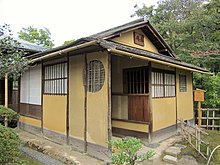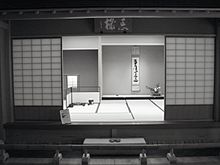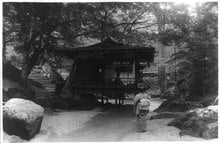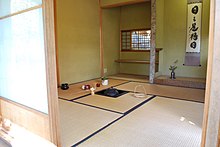
Chashitsu
Share
Chashitsu (Japanese: 茶室;) is a "tea house" which in the Japanese tradition is an architectural space designed exclusively to be used for gatherings to celebrate the tea ceremony (chanoyu).
Japanese terminology of Chashitsu

The architectural style that was developed for the construction of these chashitsu is known as sukiya style (sukiya-zukuri), while the word sukiya (数奇屋) can also designate a chashitsu.
Another Japanese term related to "tea houses" is chaseki (茶席), which broadly means "place to drink tea", and includes any kind of space where people can sit to participate in the tea ceremony, and appreciate a chabana ("tea flowers"), the style of flower arrangement characteristic of the tea ceremony.
Features
Typical features that make up a chashitsu are the shōji windows and sliding doors made of wood and covered with translucent washi paper, the tatami mat floors and the tokonoma alcove, all in the simple, subdued colors and style widely used in shoin. The size of an average chashitsu is 4.5 tatami mats (7.29 m²).
Architectural concept of Chashitsu

For Japanese architecture, chashitsu must be totally independent structures, designed specifically for the tea ceremony, with attached rooms, all of which serve as halls to receive guests to the tea ceremony, extending the concept of the "tea house" to the path itself, which, through a roji garden, leads to the chashitsu itself.
Teahouses" are usually small, simple wooden buildings. They are located in the gardens or grounds of private homes. Other common places to find a chashitsu are the grounds of temples, museums and parks.
The smallest teahouse will have at least two rooms: a main room where the host and guests gather and tea is served, and a mizuya, where the host prepares the sweets and utensils for the Japanese tea ceremony. The entire structure could have a minimum total area of three tatamis (4.86 m²).
Large "tea houses" may have several tea rooms of different sizes, with a large, well-equipped mizuya, resembling a modern kitchen, a large waiting room for guests; a welcome area where guests are greeted and can remove and store their shoes, separate bathrooms for men and women, a dressing room, a storage room; and possibly several antechambers, as well as a garden with a roji path, an outdoor waiting area for guests, and even toilets.
The "tea house" may use a portable brazier (furo) or a fire pit sunk into the floor (ro), especially for preparing tea in the winter.
Chashitsu Historical origins

The term chashitsu came into use after the beginning of the Edo period (around 1600). In earlier times, various terms were used for spaces used for the tea ceremony, such as chanoyu zashiki (茶湯座敷; "sitting space for chanoyu", sukiya ("place for poetically inclined aesthetic pursuits [Furyu,風流] such as chanoyu") and kakoi (囲; "partitioned space").
An old account says that it was the shōgun Ashikaga Yoshimasa who built the first chashitsu at his Higashiyama country house in Kyoto,6 which was described as a small room of 4.5 tatamis that was separate from the shōgun's main residence.
According to Japanese historian Takeshi Moriya in his article The Mountain Dwelling within the City, the ideal of wabi-cha (a very traditional Japanese tea ceremony style associated with Sen no Rikyū) had its roots in the urban society of the Muromachi period (1336-1573), which took shape in the "tea houses" that townspeople built in their residences and affected the appearance of thatched-roof huts in mountain villages.
Prior to this, the tea ceremony was generally enjoyed in rooms built in the shoin-zukuri architectural style, a style often employed in tea rooms built today.
Teahouses" first appeared in the Sengoku period, from the mid-15th century to the early 17th century, at a time when the central government had almost no practical power and the country was in chaos, wars and frequent uprisings.
The samurai were busy, acquiring and defending territories, promoting trade and overseeing the production of farms, mills and mines, as de facto rulers.
As the poorest were eager to seek salvation in the afterlife according to the teachings of Buddhism, "teahouses" were built mainly by Zen monks and also some feudal rulers, warriors and merchants who practiced the tea ceremony.
Simplicity and tranquility, central tenets of Zen philosophy, were sought. The recognition of simplicity and simplicity is one of the central motivations for the "tea house," which became a distinctive Japanese tradition in later periods.
The "golden tea room" was a portable gilded chashitsu built during the 16th century Azuchi-Momoyama period for the tea ceremonies of the Japanese regent Toyotomi Hideyoshi.
The original room has been lost, but several replicas have been built. The "golden tea room" was built to impress guests with the regent's power. This contrasted with the rustic aesthetic ruled by the tea master Sen no Rikyū, although there is speculation that Rikyū would perhaps have collaborated on the design.
In any case, the opulence of such a room was highly unusual and may also have been against wabi-sabi norms.
At the same time, the simplicity of the overall design, with its clean lines could be seen as within the canon. The extent of Rikyū's involvement in the design of the room is unknown, however, the master was present on several occasions when tea was served to guests in the room.
Chashitsu In Japanese architecture

The ideal "tea house" is surrounded by a small Japanese garden called a roji and is divided, at least in two parts, by a gate called a chumon.
Along the path is a guest bench and a pergola. Apart from its own garden, the chashitsu may be arranged together with other traditional Japanese buildings such as the zashiki, the oku no zashiki and the hanare zashiki, all of them around a larger main garden.
Near the "tea house" is a stone basin, where guests rinse their hands and mouths before entering the tea room through a low, square door called a nijiriguchi, or "crawl entrance," as it requires bending down to pass through. The nijiriguchi symbolically separates the small, simple and quiet interior from the noisy, overwhelming and crowded outside world. The nijiriguchi leads directly into the tea room.
The tea room has a low ceiling and no furniture: the guests and the host sit on the floor in the seiza style. All materials used are deliberately simple and rustic. In addition to the guest entrance, there may be several other entrances. At a minimum there is an entrance for the host known as a sadōguchi, which allows access to the mizuya.
There will be a tokonoma (scroll niche) holding a calligraphy scroll or brush painting, and perhaps a small, simple flower arrangement called a chabana (茶花), but no other decorations.
The mats we may find in a large chashitsu are called hiroma ("large room"), while the smaller ones are called koma ("small room").
Something that influences the construction of a chashitsu, as a space for an iemoto master or for a head of a family, is the iconography of their ancestors and personal or family memories.
Most common names of Chashitsu
It is common for a chashitsu to be named in honor of its owners or benefactors. The names usually include the characters for "hut", "hall" or "pergola", and reflect the spirit of the rustic simplicity of the tea ceremony and the teachings of Zen Buddhism. The most common names are:- Mugai-an (無外庵; introverted hut).
- Mokurai-an (黙雷庵; silent thunder hut)
- Tōkyū-dō (東求堂; hall of the eastern quest). It is clarified that the 東求堂 at Ginkaku-ji is pronounced Tōgu-dō, and is a private Buddhist hall, not a chashitsu.
- Shō-an (松庵; pine hut).
- Ichimoku-an (一木庵; a tree hut)
- Rokusō-an (六窓庵; six-window hut).
- Bōji-tei (忘路亭; pergola on the forgotten road)
Chashitsu Notable buildings
- Tai-an (待庵) built in 1582, is the only extant chashitsu designed by Sen no Rikyū, representing his concept of wabi-cha. It is located at the Myōki-an temple in Yamazaki, Kyoto. Designated a National Treasure of Japan.
- Jo-an (如庵) was built in Kyoto in 1618 by Urakusai, the younger brother of Oda Nobunaga, and was moved to Inuyama in Aichi in 1972. In 1951 it was declared a National Treasure.
- Konnichi-an (今日庵; today's hut) built by Sen Sōtan on what would later become known as the Urasenke Konnichian estate.
- Fushin-an (不審庵; hut of doubt) of Sen no Rikyū which was moved by his son Sen Shōan to the Omotesenke estate.
- Zangetsu-tei (残月亭; morning moon pergola) which belongs to the Omotesenke school in Kyoto.
- San-meiseki (三名席; the three famous tea rooms):
- Sarumen Chaseki (猿面; monkey-faced tea room) at Nagoya Castle, a former national treasure until its destruction in 1945, and rebuilt in 1949.
- Yatsu-mado no seki (八窓の席; eight windows) or Hasō-an (八窓庵) at Isshin-ji in Osaka, designed by Lord Kobori Enshū (1579-1647)
- Rokusō-an (六窓庵, hut of the eight windows) at Kōfuku-ji in Nara, now in the gardens of the Tokyo National Museum2021
- Shōkin-tei (松琴亭) at Katsura Imperial Villa in Kyoto.
- The "golden tea room" built under the regent Toyotomi Hideyoshi (1537-1598).
- Glass teahouse - KOU-AN (光庵; light hut) designed by Tokujin Yoshioka (1967).
- Ki-an bamboo tea house.





